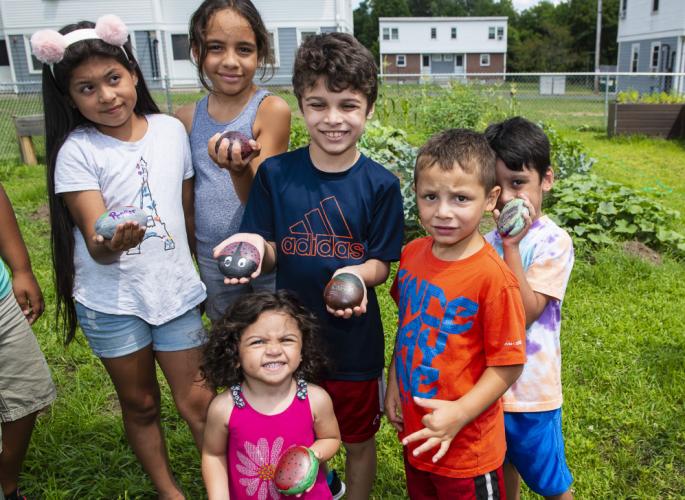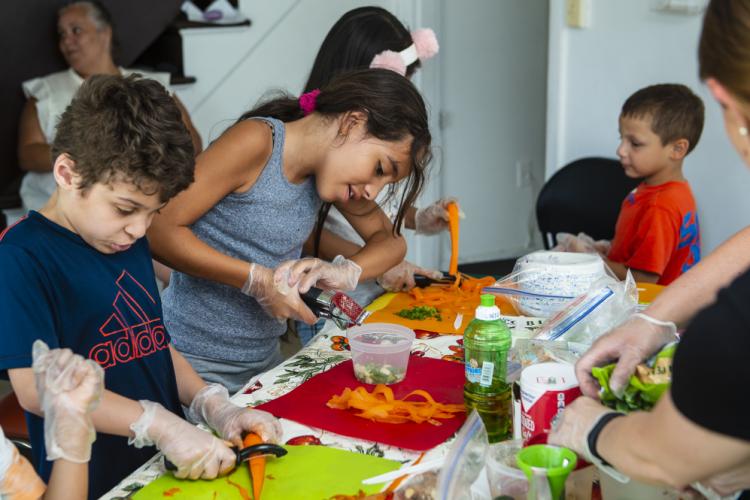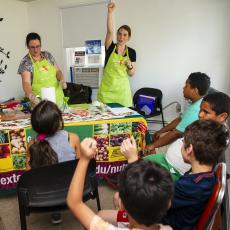In Our Spotlight
Growing a Crop of Healthy Eaters
“And how are the children?”
-- traditional greeting of the Masai tribe of east Africa
 Far from east Africa, this question remains a reminder of the importance of the well-being of a community’s children. In Springfield, Massachusetts, there is a caring community at Robinson Gardens, a low-income housing complex owned by the Springfield Housing Authority, where many adults nurture children with a specific focus on the benefits of eating foods good for their bodies. Among those who regularly show up to help are enthusiastic gardeners, generous community partners, and skilled nutritionists from the SNAP-Ed Program of the University of Massachusetts Amherst: all there to educate, encourage and introduce nourishing foods.
Far from east Africa, this question remains a reminder of the importance of the well-being of a community’s children. In Springfield, Massachusetts, there is a caring community at Robinson Gardens, a low-income housing complex owned by the Springfield Housing Authority, where many adults nurture children with a specific focus on the benefits of eating foods good for their bodies. Among those who regularly show up to help are enthusiastic gardeners, generous community partners, and skilled nutritionists from the SNAP-Ed Program of the University of Massachusetts Amherst: all there to educate, encourage and introduce nourishing foods.
And the reaction of the children? With such support, it turns out that the youngsters are willing (and eager!) to try new healthful foods. The point of the effort lies in the hope that improvement in their eating habits will last their lifetimes.
UMass Extension in Springfield: Teaching Children and Adults
On a beautiful day last summer, families who live at Robinson Gardens took part in food-based activities and physical exercise, part of extension and outreach from UMass. Nutritionists Amanda McCabe-Hernandez and Emily Lawler, trained in SNAP-Ed lessons, visited this site throughout the summer, as they have for four years. They have formed tight bonds with the children and adults who attend classes to learn how to make better food choices. Trust in these two has been carefully cultivated in this community and it shows.
McCabe-Hernandez and Lawler’s typical lesson has many components. Children two to twelve years old learned about the vegetables that they planted and tended in an onsite garden. Large colorful images of vegetables with their roots, leaves, flowers and fruit promoted identification and literacy. Proper types and amounts of food were taught through use of MyPlate, an updated version of the food pyramid.
(According to a study by the National Center for Health Statistics, the average weight of an American has increased considerably since the 1960’s. We are roughly one inch taller, but on an average, we are nearly 25 pounds heavier. USDA recently reconfigured healthier portions and types of food now recommended in MyPlate.)
During food preparation, food safety techniques were introduced, including handwashing and the use of gloves. Kids chopped, diced and tossed salads together using the tomatoes, basil and spinach that had grown under their watchful eyes.
 At the conclusion of the day, McCabe-Hernandez led children in outdoor exercises to encourage body movement and strength. Meanwhile, in the classroom, Lawler taught adults how to make easy, tasty spinach and strawberry salad, and everyone had the chance to try it. Both nutritionists agree that, when working with youth, it is all about exposure to healthful foods. At Robinson Gardens, some had never before seen zucchini, but by growing it themselves, they became excited and eager to give it a try. A spiral noodle maker was introduced and the kids had fun making zucchini noodles and enthusiastically gobbling them up.
At the conclusion of the day, McCabe-Hernandez led children in outdoor exercises to encourage body movement and strength. Meanwhile, in the classroom, Lawler taught adults how to make easy, tasty spinach and strawberry salad, and everyone had the chance to try it. Both nutritionists agree that, when working with youth, it is all about exposure to healthful foods. At Robinson Gardens, some had never before seen zucchini, but by growing it themselves, they became excited and eager to give it a try. A spiral noodle maker was introduced and the kids had fun making zucchini noodles and enthusiastically gobbling them up.
Back inside, Ivette Fernandez, a grandmother from Robinson Gardens, said “the salad was so easy! I would never have thought of mixing strawberries with spinach, but I know my kids will eat it.” McCabe-Hernandez often sees Robinson Garden youth throughout the school year when she teaches nutrition programs in schools. After her first year of offering SNAP-Ed programs at Robinson Gardens, several asked if she would be returning to run the garden club with them, “one boy even wanted me to write down the dates so he could put it on his calendar, even though it was not for several weeks!”
“In one of my adult workshops, a parent talked about how much soda she and her son consumed (over two liters a day, each). When I returned to this location to teach again, this mother told me she was so inspired by my talk that she and her son had stopped drinking soda. She had lost 40 pounds and had gotten better control over her diabetes. It felt amazing to inspire and have such an impact,” Lawler shared.
Green Thumb Squad
 A few years ago, the first children’s garden at Robinson Gardens was planned by residents with assistance and guidance from gardeners and community organizers. Anna Gilbert-Muhammed, a volunteer with Gardening the Community in Springfield, helped train adults and children in proper soil amendments and smart choices of types of plants that could flourish. By early August, melon vines and tomato plants grew side by side. An abundant herb garden sprouted up alongside deep purple eggplants. Colorful tires and other playful objects helped make the garden inviting: it had become a refuge of growth and education. When Pat Harmsen, UMass Extension’s nutrition program supervisor in Springfield, attended a class, she observed that, “Amanda is showing them how to increase their appetites for fruits and vegetables, and to instill in all, especially youth, the love of gardening. These children will be our future gardeners.”
A few years ago, the first children’s garden at Robinson Gardens was planned by residents with assistance and guidance from gardeners and community organizers. Anna Gilbert-Muhammed, a volunteer with Gardening the Community in Springfield, helped train adults and children in proper soil amendments and smart choices of types of plants that could flourish. By early August, melon vines and tomato plants grew side by side. An abundant herb garden sprouted up alongside deep purple eggplants. Colorful tires and other playful objects helped make the garden inviting: it had become a refuge of growth and education. When Pat Harmsen, UMass Extension’s nutrition program supervisor in Springfield, attended a class, she observed that, “Amanda is showing them how to increase their appetites for fruits and vegetables, and to instill in all, especially youth, the love of gardening. These children will be our future gardeners.”
Community Partners
Caring for children in any community requires a wide circle of compassionate adults who understand elements of growth and development that will steer them towards success. Lynne Cimino is the spirited outreach coordinator for Robinson Gardens. She knows the youth and their families in this 136-unit public housing complex. For the last four years, she has joined UMass nutritionists at each of their programs to identify ways to help children become more engaged in growing their own food. Cimino helps to make their garden space more inviting. She recently organized a project to paint tires with bright colors, creating fun cartoon characters adjacent to squash and potatoes. She also made a playful teepee using bamboo poles for shoots and tendrils of green peas to wrap around. Cimino works with others in the community including BMC Healthnet to fund important aspects of the garden including a shed, seeds and fencing.
Cimino said “this food promotes healthier lifestyles where people celebrate, grow, and cook together, as stronger bonds are built amongst residents.” She is especially pleased to experience the spin-off effects of UMass’s extension nutrition program since parents are now requesting cooking classes and food demonstrations, a welcome change since 2015. Cimino joins McCabe-Hernandez and Lawler in promoting literacy, practical math, responsibility and communication woven throughout their work through a project of Springfield schools called Talk/Read/Succeed.
Another important community collaborator is Anna Gilbert-Muhammad. She learned about farming through Northeast Organic Farming Association (NOFA) and is a member of the Springfield Food Policy Council. She visits Robinson Gardens at the beginning of the season to plant seedlings with residents. She then comes throughout the season to conduct programs around the technical aspects of gardening such as soil health, how many plants to put in an area, how to prune plants, and what the leaves of plants can tell you about its health. Hands-on practical skills are embedded in her lessons (which the children seem to soak up).
This Work Does Make a Significant Difference
SNAP-Ed--Supplemental Nutrition Assistance Program Education—is a nutrition education program for adults and youth who receive or are eligible for SNAP benefits. SNAP-Ed’s mission is to help participants make healthy food choices and choose active lifestyles, within limited budgets. UMass Amherst is the state’s largest provider of SNAP-Ed programming, with offices and nutritionists in Lawrence, Boston, Raynham, Springfield, Worcester, and Barnstable.
SNAP-Ed’s numbers tell a story of real impact. In FY18, UMass Extension SNAP-Ed partnered with 118 community agencies and organizations throughout Massachusetts. A total of 70,208 SNAP-Ed participants were reached with direct education, made up of 3,366 adults and 66,842 youth. Youth program participation showed statistically significant behavior changes:
• Youth (grades 3–8) ate more fruits and vegetables after completing a series of nutrition lessons.
• Youth (grades 3–5) were more physically active after completing a series of nutrition lessons.
• Youth (grades 6 –8) were spending less time watching TV or movies, playing electronic games,
or using the computer for something other than schoolwork after completing a series of
nutrition lessons. More details about SNAP-Ed.
Take away lessons
 Back at Robinson Gardens, the University nutritionists had some final encouraging words for our readers. Lawler advised people not to be intimidated by healthy diet choices. She suggested that we can make small changes (such as adding one additional serving of vegetables to lunch or cutting back on soda). These little improvements can really add up over time.
Back at Robinson Gardens, the University nutritionists had some final encouraging words for our readers. Lawler advised people not to be intimidated by healthy diet choices. She suggested that we can make small changes (such as adding one additional serving of vegetables to lunch or cutting back on soda). These little improvements can really add up over time.
And for those of who have grown beyond our childhood, McCabe encouraged readers to know, “It’s never too late to start making healthy choices. Don’t be too hard on yourself and enjoy discovering all the delicious varieties of healthy food available.”
Finally, “and how are the children?” In Springfield, Massachusetts, the children living at Robinson Gardens are reaping the benefits of strong leadership in nutrition and skill-building lessons.
See UMass Extension’s delicious healthy recipes and nutrition information.




